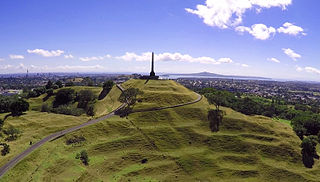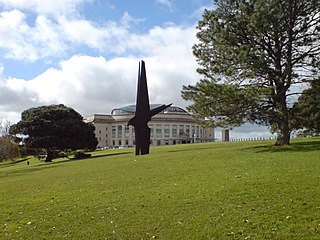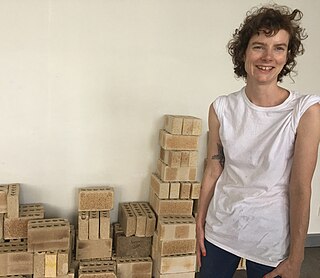Related Research Articles

Maungakiekie / One Tree Hill is a 182-metre (597 ft) volcanic peak and Tūpuna Maunga in Auckland, New Zealand. It is an important place culturally and archeologically for both Māori and Pākehā. The suburb around the base of the hill is also called One Tree Hill. It is surrounded by the suburbs of Royal Oak to the west, and clockwise, Epsom, Greenlane, Oranga, and Onehunga. The summit provides views across the Auckland area, and allows visitors to see both of Auckland's harbours.

South Auckland is one of the major geographical regions of Auckland, the largest city in New Zealand. The area is south of the Auckland isthmus, and on the eastern shores of the Manukau Harbour. The area has been populated by Tāmaki Māori since at least the 14th century, and has important archaeological sites, such as the Ōtuataua stonefield gardens at Ihumātao, and Māngere Mountain, a former pā site important to Waiohua tribes.

Māngere is a major suburb in South Auckland, New Zealand, located on mainly flat land on the northeastern shore of the Manukau Harbour, to the northwest of Manukau City Centre and 15 kilometres south of the Auckland city centre. It is the location of Auckland Airport, which lies close to the harbour's edge to the south of the suburb.

Māngere Mountain, also known by the names Te Pane-o-Mataaho and Te Ara Pueru, is a volcanic cone in Māngere, Auckland. Located within Māngere Domain, it is one of the largest volcanic cones in the Auckland volcanic field, with a peak 106 metres (348 ft) above sea level. It was the site of a major pā and many of the pā's earthworks are still visible. It has extensive panoramic views of Auckland from its location in the southeastern portion of the city's urban area.

The Auckland Domain, also known as Pukekawa / Auckland Domain, is a large park in Auckland, New Zealand. Consisting of 75 hectares of land, Auckland Domain is the oldest park in the city. Located in the central suburb of Grafton, the parkland is the remains of the explosion crater and most of the surrounding tuff ring of the Pukekawa volcano.

Papakura is a suburb of South Auckland, in northern New Zealand. It is located on the shores of the Pahurehure Inlet, approximately 32 kilometres (20 mi) south of the Auckland City Centre. It is under the authority of the Auckland Council.

Puketutu Island, also known as Te Motu a Hiaroa, is a volcanic island in the Manukau Harbour, New Zealand, and is part of the Auckland volcanic field. European settlers called it Weekes' Island, but this was eventually abandoned in favour of the historical Māori name. The island is joined to the mainland via a causeway known as Te Ara Tāhuna.

Maungataketake is one of the volcanoes in the Auckland volcanic field in New Zealand. It had a 76 m high scoria cone, beside a 100 m wide crater, before they were quarried away. It was the site of a pā. Layers of volcanic tuff and ash from Maungataketake overlay the fallen trunks of the nearby Ihumātao fossil forest. The New Zealand Ministry for Culture and Heritage gives a translation of "broad mountain" for Maungataketake.

Ihumātao is an archeological site of historic importance in the suburb of Māngere, Auckland. Once a pā site, it stands on the Ihumātao Peninsula, at the base of Ōtuataua, part of the Auckland volcanic field. Its scoria cone reaches 64 metres (210 ft) above sea level.
This is a timeline of the history of the city of Auckland in New Zealand.

Tāmaki Māori are Māori iwi and hapū who have a strong connection to Tāmaki Makaurau, and whose rohe was traditionally within the region. Among Ngā Mana Whenua o Tāmaki Makaurau, also known as the Tāmaki Collective, there are thirteen iwi and hapū, organised into three rōpū (collectives), however Tāmaki Māori can also refer to subtribes and historical iwi not included in this list.
Elizabeth Mary Rata is a New Zealand academic who is a sociologist of education and a professor in the School of Critical Studies in Education at the University of Auckland. Her views and research on Māori education and the place of indigenous knowledge in the New Zealand education system have received criticism from other academics, as per the academic process.

Kate Newby is an artist from New Zealand.

Pania Newton is a New Zealand lawyer and activist for Māori land rights. In 2016, Newton was a co-founder and spokesperson of the group Save Our Unique Landscape (SOUL), which protested against the development of land at Ihumātao in south Auckland from 2016 to 2020. As a result of the group's protest action, the New Zealand government purchased the land from the developer in 2020, although as of 2022 its future remains unresolved.

Te Waiohua or Te Wai-o-Hua is a Māori iwi (tribe) confederation that thrived in the early 18th century. The iwi's rohe was primarily the central Tāmaki Makaurau area and the Māngere peninsula, until the 1740s when the paramount chief Kiwi Tāmaki was defeated by the Ngāti Whātua hapū Te Taoū. The descendants of the Waiohua confederation today include Ngāti Te Ata Waiohua, Te Ākitai Waiohua, Ngā Oho of Ngāti Whātua Ōrākei and Tainui.
Mataaho is a Māori deity. Variously considered a god of earthquakes and eruptions, the guardian of the earth's secrets, the god of volcanic forces, or a giant, Mataaho is associated with many of the volcanic features in the Tāmaki Makaurau Region. In traditional Tāmaki Māori myths, Mataaho either creates the volcanic features of the landscape, or requests the gods to create them. Mataaho holds traditional significance for Te Kawerau ā Maki and Waiohua iwi, and is considered a tupuna (ancestor) of Te Ākitai Waiohua iwi.

The Pūkaki Creek, also known as the Pūkaki Inlet, is an estuarine river of the Auckland Region of New Zealand's North Island. It flows south from its sources in Māngere and Papatoetoe, entering into the Manukau Harbour. The creek is adjacent to Auckland Airport and Pūkaki Marae.
Ngā Oho, also known as Ngā Ohomatakamokamo-o-Ohomairangi, is the name of a historical iwi (tribe) of Māori who settled in the Auckland Region. In the 17th century, Ngā Oho and two other tribes of shared heritage, Ngā Riki and Ngā Iwi, formed the Waiohua confederation of tribes.

Ēpiha Pūtini, born Te Rangiata-Ahua Ngamuka and later known as Jabez Bunting was a prominent chief of Ngāti Tamaoho, who occupied the area south of Papatoetoe and through the Hunua Ranges to the Bombay Hills. As rangatira, Pūtini was involved in multiple land disputes and controversial land sales in the isthmus and south Manukau area during the 1830s and early 1840s, which led to an exchange of gunfire between individuals from Ngāti Tamaoho and neighbouring iwi Ngāti Te Ata, and resulted in several deaths on the side of Ngāti Te Ata. Pūtini is best remembered for his Wesleyan faith, which resulted in the establishment of the Ihumātao Mission Station, as well as his continued efforts to foster peace between Māori and European settlers.

Ngarino Ellis is a New Zealand academic and author. She is one of only a few in her field of Māori art history and an educator. She is an associate professor at the University of Auckland. Her first book published in 2016 is titled A Whakapapa of Tradition: One Hundred Years of Ngāti Porou Carving 1830-1930 with photography by Natalie Robertson.
References
- ↑ Stock, Rob (13 February 2022). "'Unknown histories': How a museum curator hopes to highlight Auckland's past". Stuff . Retrieved 31 January 2024.
- ↑ Rākete, Emmy (9 May 2022). "Ockham week: The book of Auckland". Newsroom. Retrieved 31 January 2024.
- ↑ "The Shifting Grounds of Tamaki Makaurau". Radio New Zealand . 16 November 2021. Retrieved 31 January 2024.
- ↑ Wilson, Simon (20 November 2021). "If you need a monument, look around you': Rethinking Auckland history". The New Zealand Herald . Retrieved 31 January 2024.
- ↑ Rawhiti-Connell, Anna (31 January 2022). "Learning to look Tāmaki Makaurau in the face: a review of Shifting Grounds". The Spinoff . Retrieved 31 January 2024.
- 1 2 "Dr Lucy Mackintosh". University of Auckland . Retrieved 31 January 2024.
- 1 2 3 Mackintosh, Lucy (2019), Shifting Grounds: History, Memory and Materiality in Auckland Landscapes c.1350–2018, ResearchSpace@Auckland, hdl:2292/46343, Wikidata Q111963316
- ↑ Mackintosh, Lucy (24 September 2019). "Why Ihumātao truly is a piece of New Zealand's soul". The Guardian. ISSN 0261-3077 . Retrieved 12 March 2023.
- ↑ Franks, Josephine (5 October 2020). "Covid-19: Aucklanders make history in museum's lockdown collection". Stuff. Retrieved 12 March 2023.